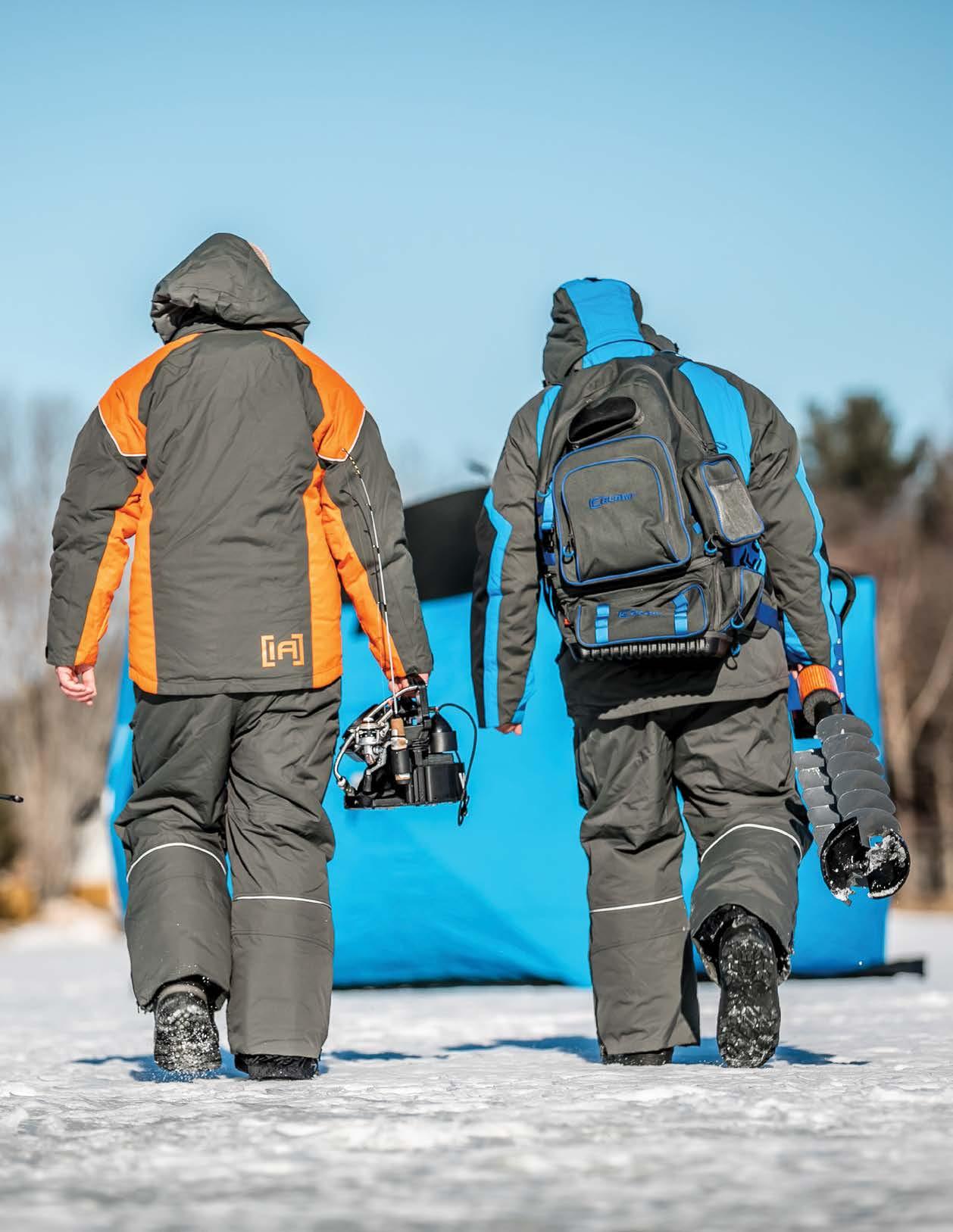


























Bring out the best in your fresh catch with Shore Lunch breading. Try our soup mixes, batter and other comfort food favorites too!



NOW
Visit us online for recipes, products and more at ShoreLunch.com
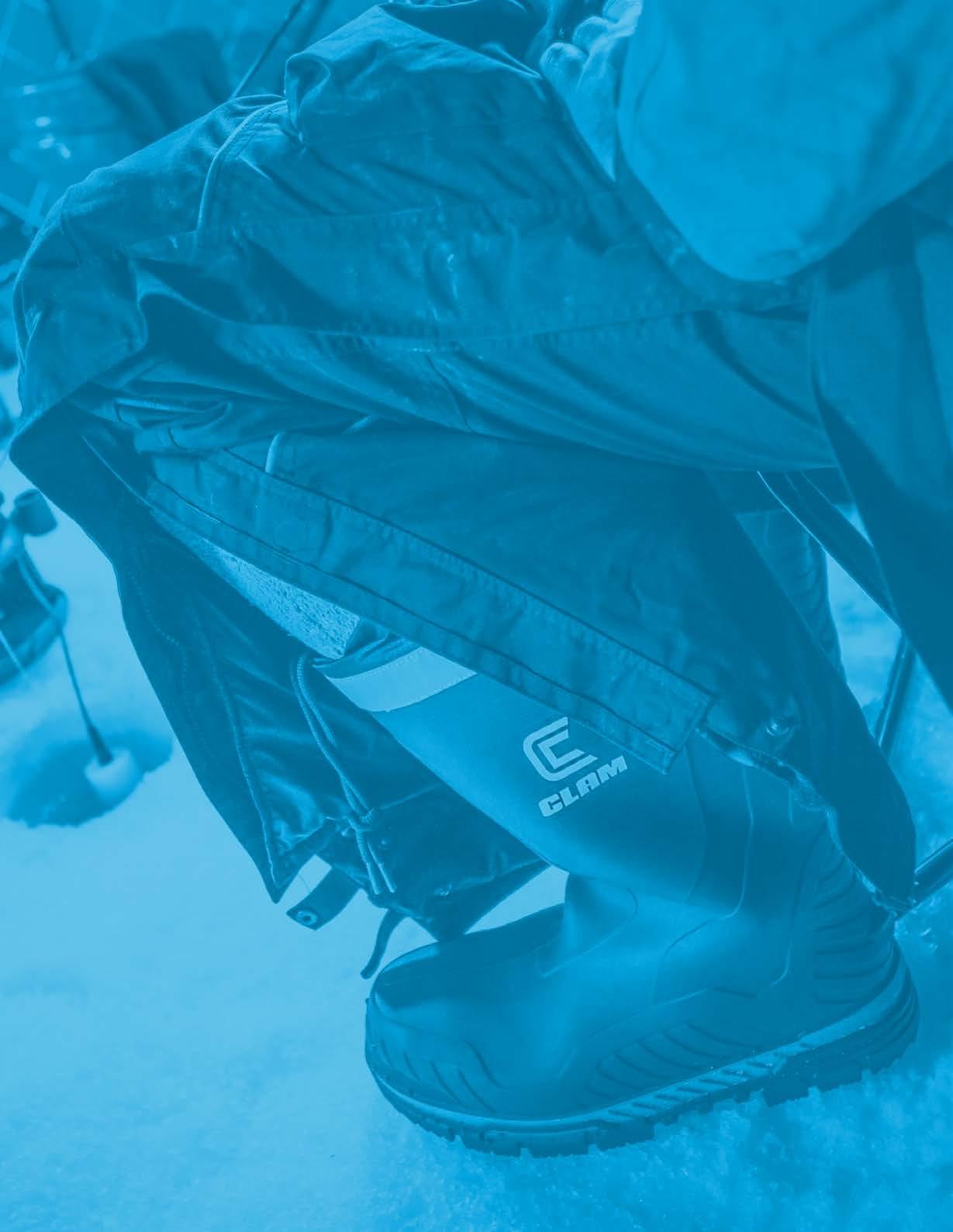

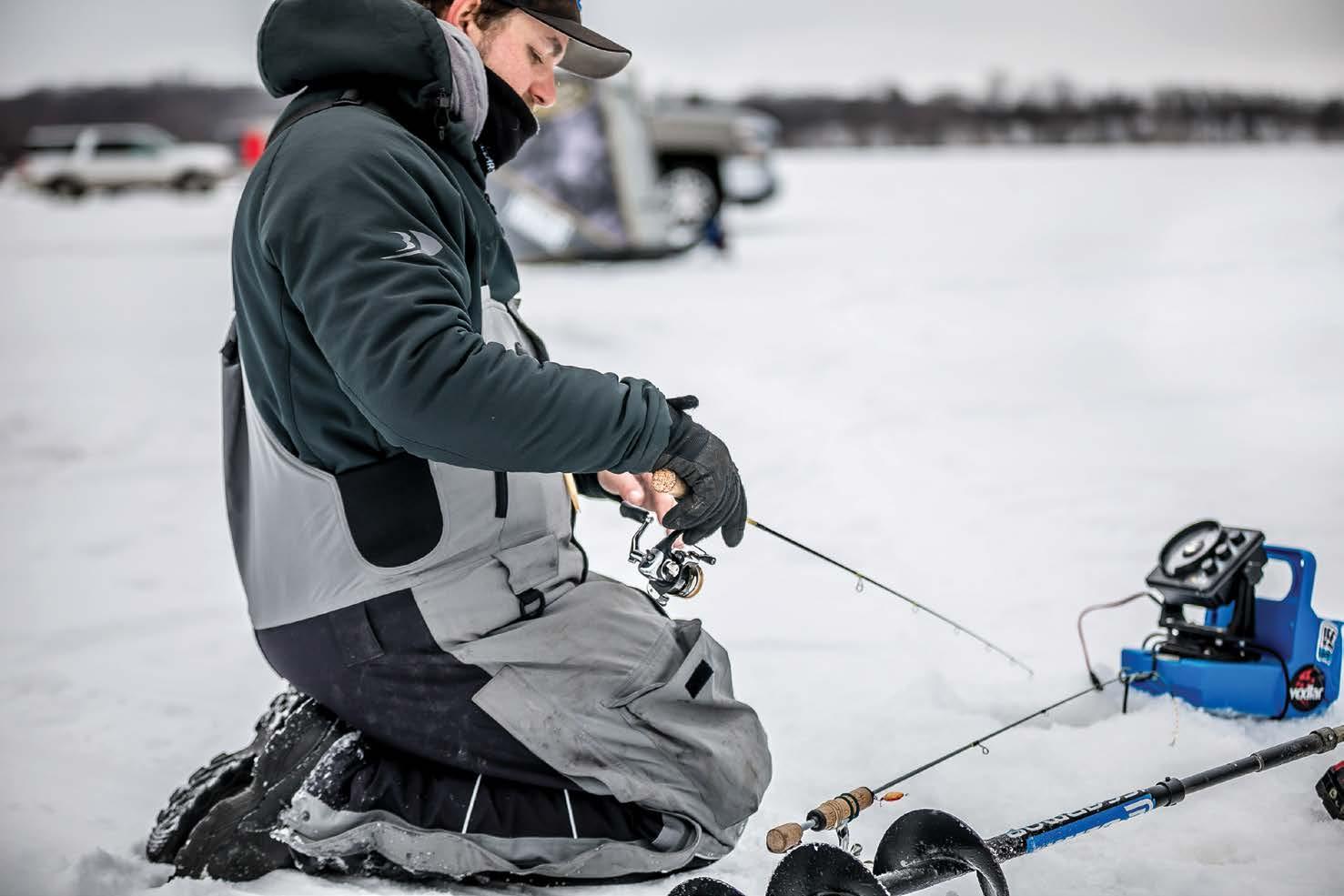

 by Jeff “Jiggy” Andersen
by Jeff “Jiggy” Andersen
ONE OF MY FAVORITE FISH
to chase throughout the winter months is no doubt giant crappies. The most addicting part is getting the rod, reel, line, lure and trigger combination correct and when you do that’s when the magic is made.
In this article, I will break down some of my favorite presentations, combinations and locations for you to consider this winter.
Lets chat a little location strategy first. If your goal is to catch a super giant crappie there are a few things I would consider. First you have to fish where they live. Sounds so simple yet it’s so easy to get stuck on the “hot bite” on your local lake
but chances are that spot has been hammered. When thinking big crappies my mind goes to either a backwoods offbeat lake or a huge body of water like my home lake Leech Lake in Northern Minnesota. The challenge with the offbeat backwoods lake is this will require some homework and failures. I can’t tell you how many times I think I have found that secret gem and to find out it wasn’t worth my effort. BUT, for every lake failed I’m one step closer to finding that one.
The challenge with the large body of water is it’s intimidating. There is so much water and so much structure to breakdown. My best advice is to break it down into sections. Look at a map and draw out sections. Stay
focused in your search.
When you do this you will be surprised at how fast you can break down a lake. Furthermore you will start to unlock the code, which will make things much less intimidating. My biggest crappies come from huge bodies of water.
Here are my three top presentations for really big crappies.
The Spoon – I believe spoons are the must underutilized lure for big crappies. To this day some of my largest crappies have been caught with a spoon. The trick is to go a bit more aggressive than fishing with a smaller tungsten jig. If you’re fishing an active school I tend to work above
the marks avoiding the smaller fish but keeping them moving in the water column. Watching my graph with an eagle eye I look for larger marks. Once I see the fish I want to target I actively try and get that specific fish to engage. The goal here is to get the giant to move out from the pack. Then your job is to finish the deal.
My Go-To Spoon Combo: The 1/16th oz Clam Blade Spoon paired with a Maki Spiiki Rod and Line Combo: 30” Legacy (Spinning Reel) with 4lb Frost Ice Monofilament
The Jig – Unlike the spoon a smaller tungsten jig is one that gets the most credit for being a crappie catcher and for good reason. I always carry a spoon combination and a tungsten jig combination with me while hole hoping. There are times throughout the season the smaller tungsten is the action the fish want. I believe it has to do steady small shakes from the rod tip that seals the deal. The great part about a tungsten is the variety of plastics you can pair with it. Spend a little time rigging up multiple
combinations and practice with each. Take a bucket of water or aquarium and watch how each combination reacts to specific jig strokes. This is so important to learn what is the trigger factor when that fish shows up on your graph.


A Swim Bait: The lure that gets the very least amount of attention is a swim style bait that moves horizontal in the water column. This is a great search lure when out over the basin. As with the previous two presentations, there are times, this particular movement is what gets the job done. With a large jig stroke and a free fall the bait will swim left to right covering a large diameter. Once the fish shows I will shorten my jig stroke while moving the bait slow up in the water column but don’t stop shaking that rod. It’s that little movement in the lure that gets them to go!


My Go-To Swim Bait: 1/8oz Clam Tikki Mino with a Maki Polli rigged on the middle treble hook.
My Go-To Tungsten Combo: Clam Drop Jig XL with a Maki Jamei
Rod and Line Combo: 26inch Legacy light action spring bobber (Spooler Reel) with 3lb Frost Ice Fluorocarbon. Note: I like the spooler reel to minimize line twist and the fluorocarbon as it has a bit less stretch. Great for detecting bites.
Rod and Line Combo: 32 inch Legacy medium light (Spinning Reel) with 6lb Frost Ice Fluorocarbon. These presentations paired up with the correct rod, reel and line combination will make a huge difference for you this winter. n
YouTube: Jeff Andersen Fishing Maki Jamei and CPT Drop jig XL
Maki Jamei and CPT Drop jig XL
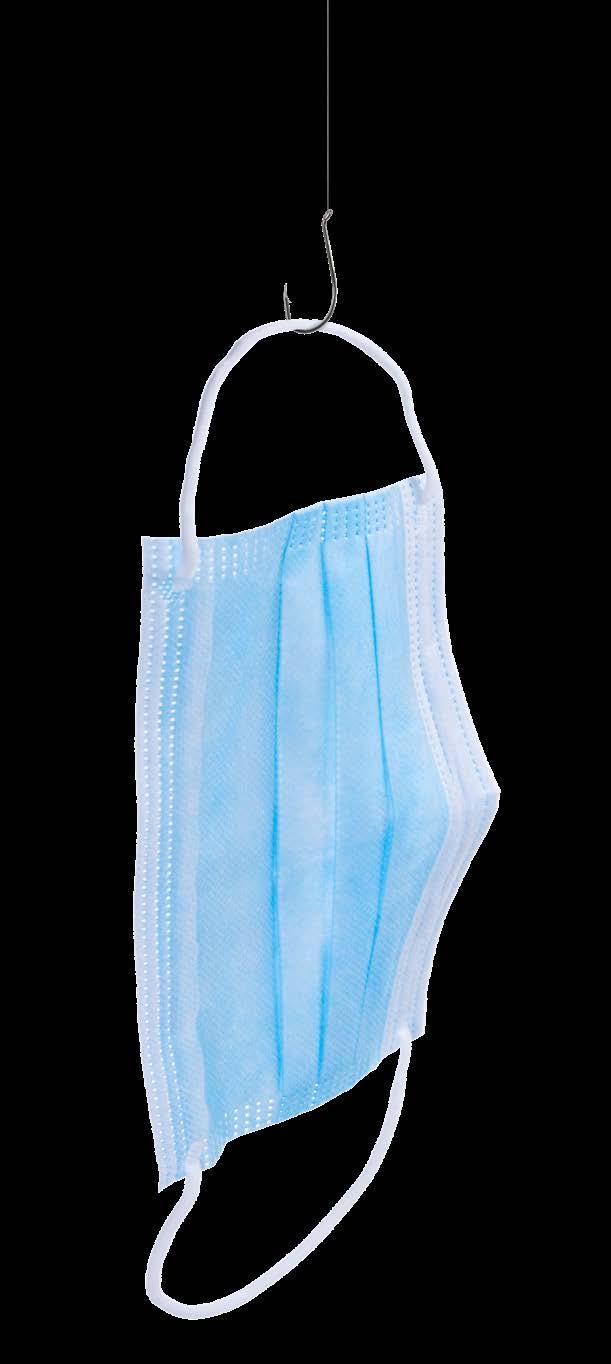
 By: Ice Team Pro, Mike Howe
By: Ice Team Pro, Mike Howe
There are few things in life that transcend fishing when it comes to the life benefits of a singular activity. Many of us who fish, and have broken down the activity into its hundreds of pieces, understand this and revel in it. Which is why, when many states banned the activity during the “lockdown,” we all wondered… “what are they thinking”? And the looming question is, “What will ICE fishing be like, with social distancing, personal hygiene and our concern for our friends and family on all of our minds this coming ice season?
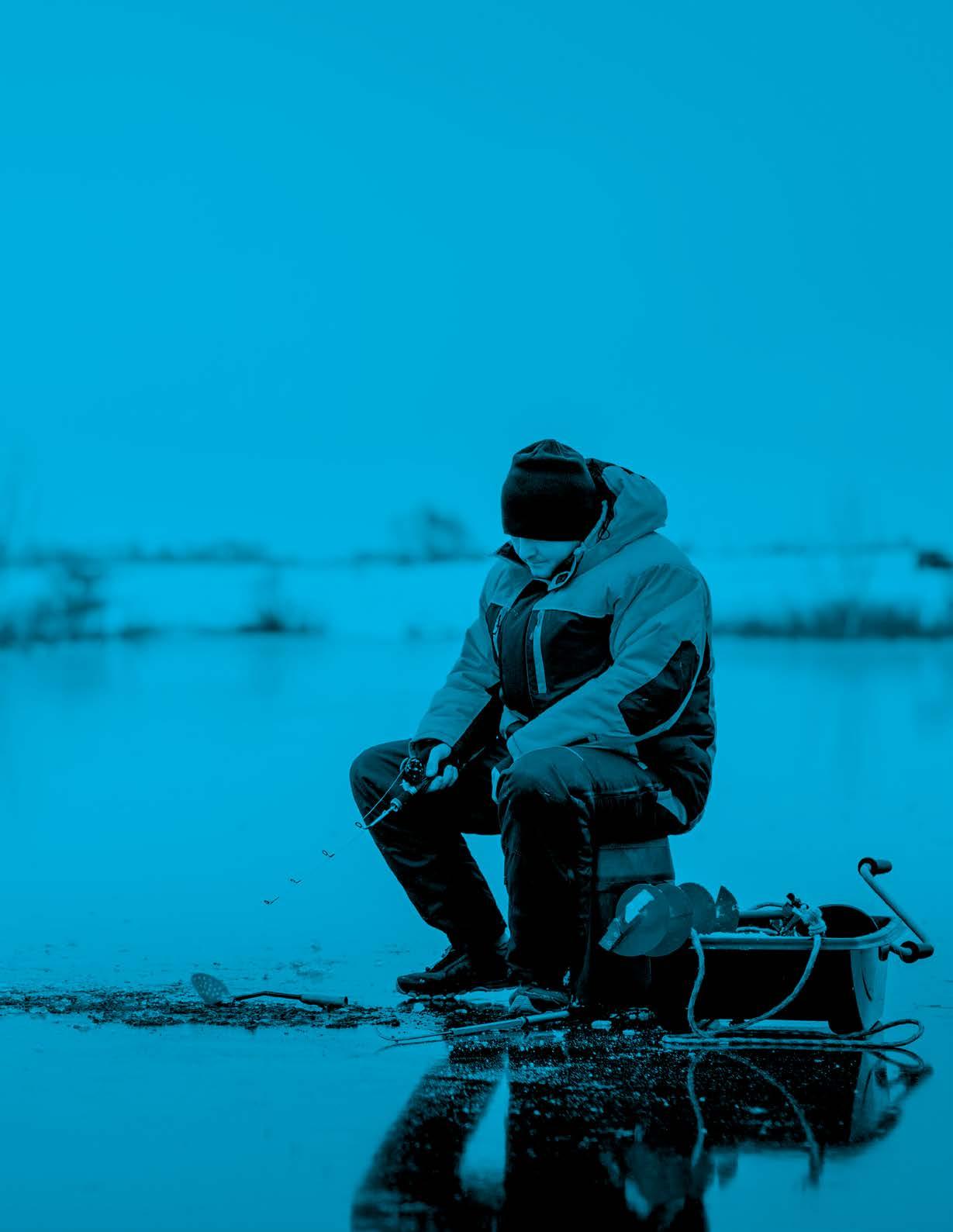
When fishing, many of us wander off to be by ourselves, if only for a little while on a group outing, and by design many other times. It is this solitude that brings not only food for the table, but food for the soul. And if no fish are caught? Well sometimes that is just what the doctor ordered. And for many of us who practice what Genz and Johnson
et al speak of as “fishing together, but separately”, well that couldn’t fit the recommended advice any better.
Fishing provides physical exercise. While perhaps not the most vigorous of exercise is the jigging of a lure, the movements involved in getting to your spot can certainly be. For some it is the hike onto the sheet of
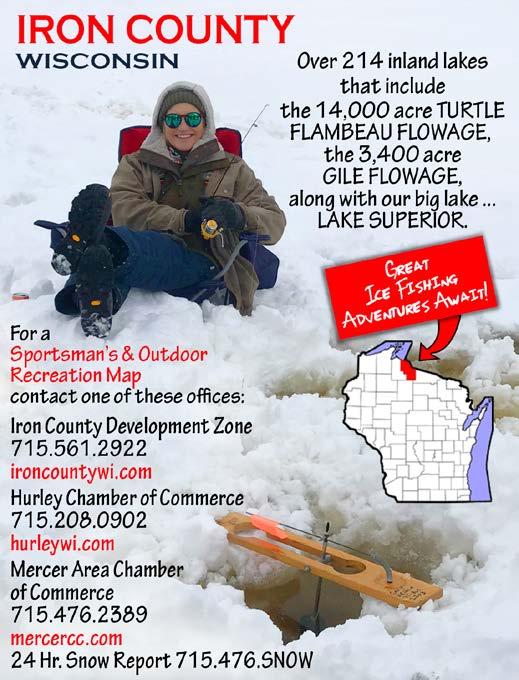
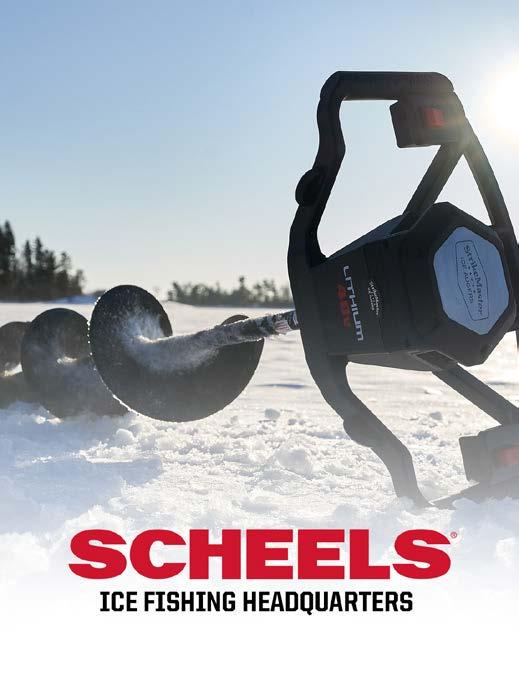
ice, and out to the spot on the spot, for others it may be the assembling of the portable shacks or the relaying of gear from one spot to the next. No denying is the chasing down of the flags as the farthest tip-ups always seem to get the most action!
Fishing provides mental exercise. Many days, the concentration required to put a program together to make those fish bite rivals a NASA space launch. The mental fortitude required to tie a good knot, match the exact jigging cadence that your buddy is using to knock them dead, or remove a hook you have buried in your finger is often times the most brain power I will expend on any given day. And let’s not deny the critical thinking that goes into telling a good fish story!
Fishing provides time in the outdoors, in the fresh air, and allows the primitive person to shine through. Trapping and storing your own minnows, and keeping them as lively as possible, is like tending

livestock or raising hunting dogs, in a way. Gutting a fish (where legal) on the ice to examine its stomach to determine the feed they are eating while dressing or filleting a fish means we handle a sharp tool that provides us hundreds of uses. And lastly, eating flesh that came at our own hands helps us connect to the earth in a way no other can. Steve Rinella eat your heart out…or don’t!
And yes, fishing in a group with sick people might expose you to an illness you might have otherwise not contracted, I don’t know anyone who is that irresponsible and would do that… pandemic or no. I know I won’t be accepting any invitations to fish in a shack if I am in the least bit sick, but putting 2-3 otherwise healthy people in a shack or wheelhouse safely and practicing good personal hygiene is probably the least risky behavior anyone will engage in. We face away from each other while casting or watching lines or netting each other’s fish on open water, and can practice these same rules while ice fishing.
Will ice fishing look a lot different this season then it has in the past? I am certain of it, from the first ice fishing show, to the last day on last ice, we will all have to make adjustments with the pandemic in the back of our minds. One thing is for sure though, I will need the emotional, physical and yes spiritual food that ice fishing brings, just as much in January of 2021 as I needed it in March of 2020…quite possibly even more so as we approach the anniversary of the virus that literally


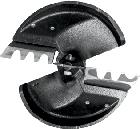
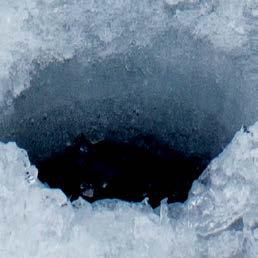
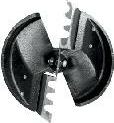





The most convenient way to ensure your tailbone won’t meet that hellaciously hard ice, just strap the Apex Ice Cleat on, grab your auger and start punching holes knowing there’s no ice condition these babies can’t sink their teeth into.
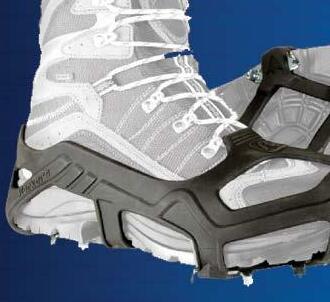



20

















For those of us who are chomping at the bit to get out on the ice and fish why wouldn’t we wear flotation, no matter if it’s early ice or mid-season ice, not all ice can be determined 100% safe at all times and as much as we don’t like to hear it, it is an important fact that we all must stay aware of whenever we are on the ice. I think to myself why didn’t we have this 20 years ago?

And I guess the simple answer is not enough people who were ice fishing then to have a suit like this in production for the mainstream market, these days everyone can get out and enjoy a beautiful winters day, and ice fishing has become very mainstream. With the times as they are, #covid or #2020. Getting outside is more popular than it’s ever been,
and I suspect this will continue into the winter months #notsobad.
Both the Ice Armor Rise suit and women’s Glacier suit have built in buoyancy to help assist if you were to break through the ice, everyone should understand that this is not a Coast Guard approved flotation device, however it does give you a buoyancy that you would otherwise not have making it much easier to get back up on top of the ice.
No matter what you’re wearing, breaking through the ice is always a very dangerous situation so standard protocol is to always be checking the thickness of the ice with a chisel or an auger and have a throwable rope with you at all times. So yeah it’s great that these suits give you an extra buoyancy if you become victim to falling through the ice, however I love these suits for more reasons than that, I would even say that my favorite feature of the suits
is the warmth and comfort, that built in buoyancy is also assisting in keeping me warm, and the motion float means I have tons of maneuverability with ease because it is also lighter in weight then warm suits from the past. Being able to freely bend down, twist around, get up, sit down, squat, and kneel on the ice in extremely cold conditions are things that I am constantly doing on the ice are done with ease in my Ice Armor motion float suit. While I have no problem wearing the men’s Ice Armor suits I really do love the women’s Glacier suit, basically the color and stretch panels throughout the suit gives it a more womanly appearance, it is very comfortable and sometimes it’s just fun not to look like one of the guys.
As we get our ice fishing gear ready for the winter season, knowing I have protection from extreme winter elements, including breaking through the ice frees up the much-needed space in my brain so I can set my mind on other things, like how I’m going to get those fish to bite! n


Wherever Your Next Adventure Takes You, CanCooker Has You Covered. Spend Less Time Cooking and More Time Doing What You Love To Do!











Yes, I am an ice fishing fanatic. Moving to the northwest Iowa from South Dakota in 1978, I found an ice fishing mecca like I had never seen before, and I could write a book about my learning curve when it came to finesse fishing. Over the next several years, I learned about the efforts of Dave Genz, known as Mr. Ice Fishing for his revolutionary ice fishing ideas that brought ice fishing literally out of the Ice Age.
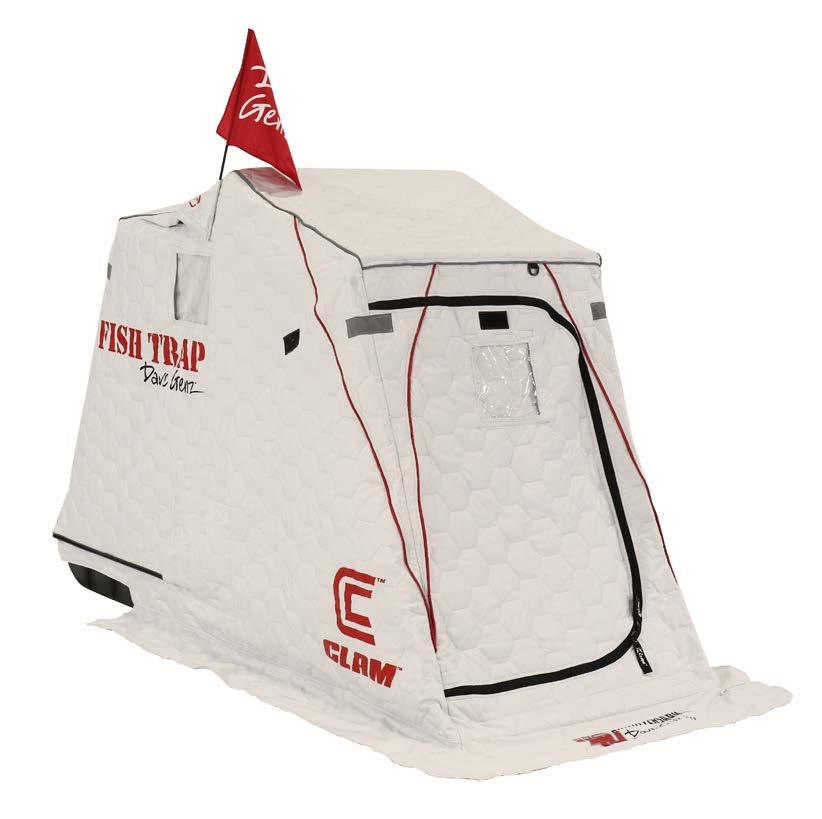
Over the past 35 years, I’ve been blessed to count Dave Genz as both a mentor and friend and to be part of the Clam Outdoors pro staff led by Genz. It’s hard for me to believe that this year marks the 40th anniversary of the original Trap portable shelter that helped revolutionize the sport of ice fishing. Yup, that’s the portable ice shack that folds over like an accordion or a clam. Look out on area lakes, and you will often spy a sea of blue, the color of the original’s direct descendants marketed by Clam Outdoors since 1992. While other manufacturers have designed their version of the original Fish Trap and have taken their place on the ice, even with all of these other designs, it is the sea of blue that continues to set the bar in ice fishing. In Dave’s words, this is how things happened. It’s quite a story.
Dave says, “Ice fishing has been in my life forever. I don’t ever remember not ice fishing. Everything we have

done has been about helping make folks better ice anglers. We’ve been working on this for a lot longer, and there were many different prototypes through the years made from materials we could scrape together. But it’s been in the last 40 years that we’ve been making and sharing the Fish Trap with the ice fishing world.”
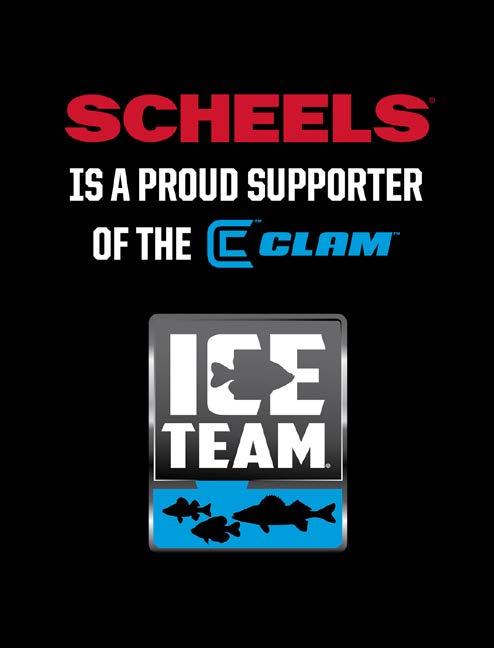
A chance vehicle accident led to the ice fishing portable shelter venture. “I was coming back on a fishing trip on HWY 65, heading into Minneapolis. I passed a vehicle pulling an 8 x 8-foot fish house on a trailer. As I passed, it came unhooked and slammed into
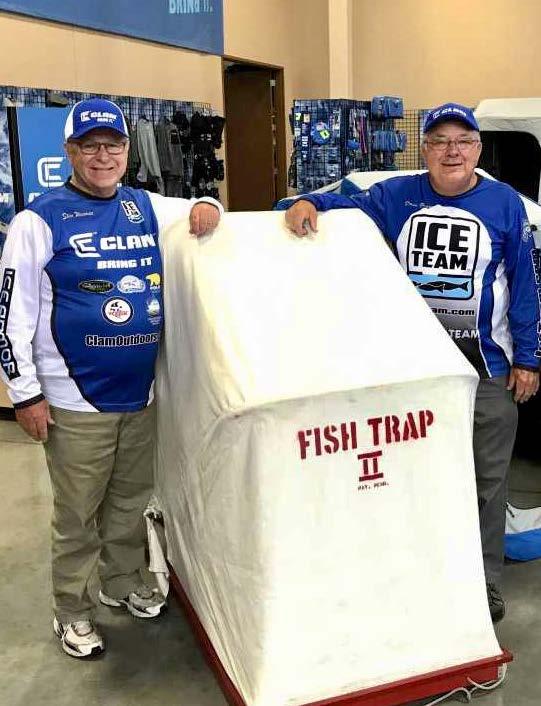
the side of my car. With the insurance money, that’s where I got the check, I decided to use that money to get started building fish houses.”
It all began in Dave’s garage, and the first ones were made of cotton canvas, metal electrical conduit piping for the moving parts and a wood base. Definitely heavier than the later models, but with nothing like it, those first Fish Traps quickly took off. The Fish Traps brought more angler mobility, and it certainly beat being outside in sub-zero weather. Anglers soon found that the added mobility greatly improved fishing success, and often times fishing a new hole meant a bite.
The building crew included Dave, his wife, Patsy and their two daughters Missy and Kathy. “Patsy sewed all of the cloth on her sewing machine for each trap. She sewed the cloth so that none of the conduit was showing,” notes Dave. “We made five in the first year, 20 in the next and
“Patsy sewed all of the cloth on her sewing machine for each trap. She sewed the cloth so that none of the conduit was showing,”The author (L) and Dave Genz (R) with the 40th Commemorative Fish Trap.
then 80.” At that point, it became too much for Patsy. “Finally, we went to a tent and awning company. It’s funny, it cost us less to have that company make 100 than the 80 we made ourselves the year before!”







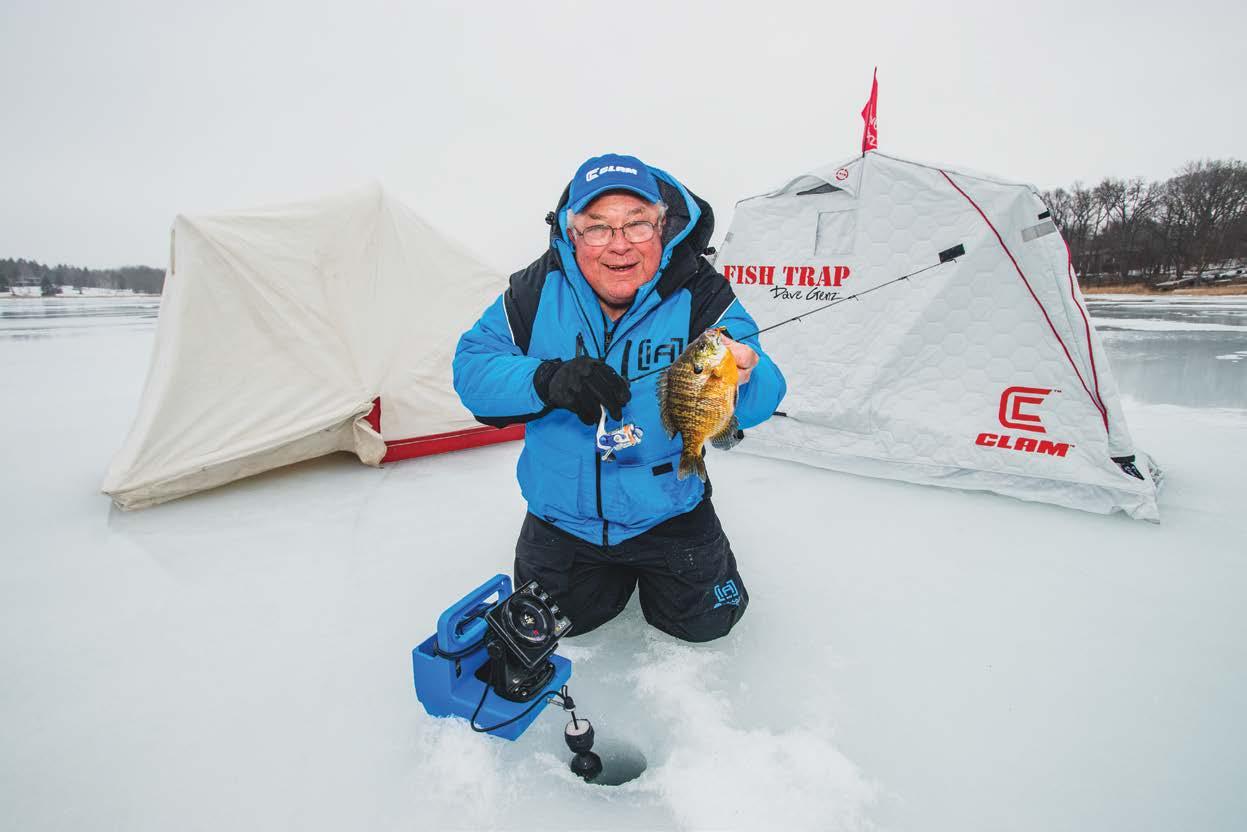
Missy and Kathy were young girls at the time and, according to Dave, “They would use their money that they earned to go skating on Saturdays.” Kathy says looking back, “We were both honored to be a part of it!”
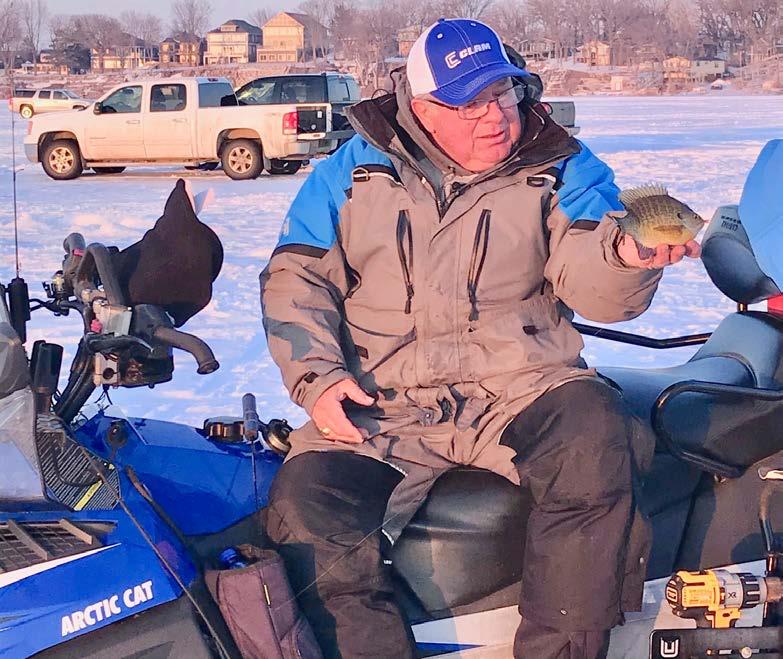
“They would use their money that they earned to go skating on Saturdays.” Kathy says looking back, “We were both honored to be a part of it!”Dave Genz catches a nice mid-winter West Okoboji bluegill. The Arctic Cat snowmobile offers Genz mobility to get from spot to spot. The Cat carries his Fish Trap, Vexilar, battery powered auger and all of his ice fishing equipment.
Marketing in the beginning was Dave going out and visiting bait shops and showing them what he had invented. “I spent a lot of time on the phone, and I’d go store to store by myself, and when it came to shipping out the Fish Trap, it was the cheapest to send by Greyhound buses. I don’t think the drivers were too thrilled when they had to put those big boxes on their buses.”
The rest is history as the Fish Trap has become the time-honored bar when it comes to portable fishing shelters. Dave does not spend the time on the road anymore, and Missy and Kathy are there to offer continued support as he continues to share his ice fishing knowledge with the ice fishing world. Sadly, the fourth member of the team, Patsy, passed away in early March of 2020.

The invention of the Fish Trap was just the beginning. There is the fishing system (a total logical
system of ice fishing), the mobility caused by the Fish Trap, the Vexilar locators to “see” what’s below the ice, actual ice fishing finely tuned rod/reel combinations, the ice specific tiny ice jigs that now includes an entire line of tungsten jigs, the presentation cadence (ways to entice finicky fish), the augers (gas powered and now battery powered), the heaters, the clothes. Dave continues to work with Clam Outdoors, leading its pro staff and offering to share his knowledge with the fishing world. Videos and books have been written about Dave Genz and his ice fishing theories. What a feeling it must be knowing that you have been at the forefront of this entire process and now carry the title of Mr. Ice Fishing.
Dave has also been inducted into the Minnesota Hall of Fame (2002) and the National Freshwater Hall of Fame (2011). As an ice fisherman, I’ve learned so much from Mr. Ice Fishing, and I consider it an honor to call him a mentor and a friend. n
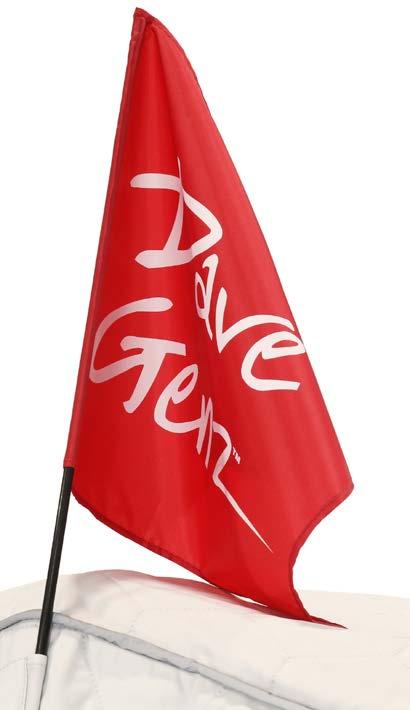


If there is one thing that underwater cameras have taught us it’s that even with the most sensitive rod, fish of all species have the ability to eat and spit a lure without even the most veteran angler feeling it. While most anglers know this to be true with species such as bluegill, I can promise you larger species such as walleye routinely do it to us as well. Here are three things to consider so you can get the bite, even if you don’t feel it.
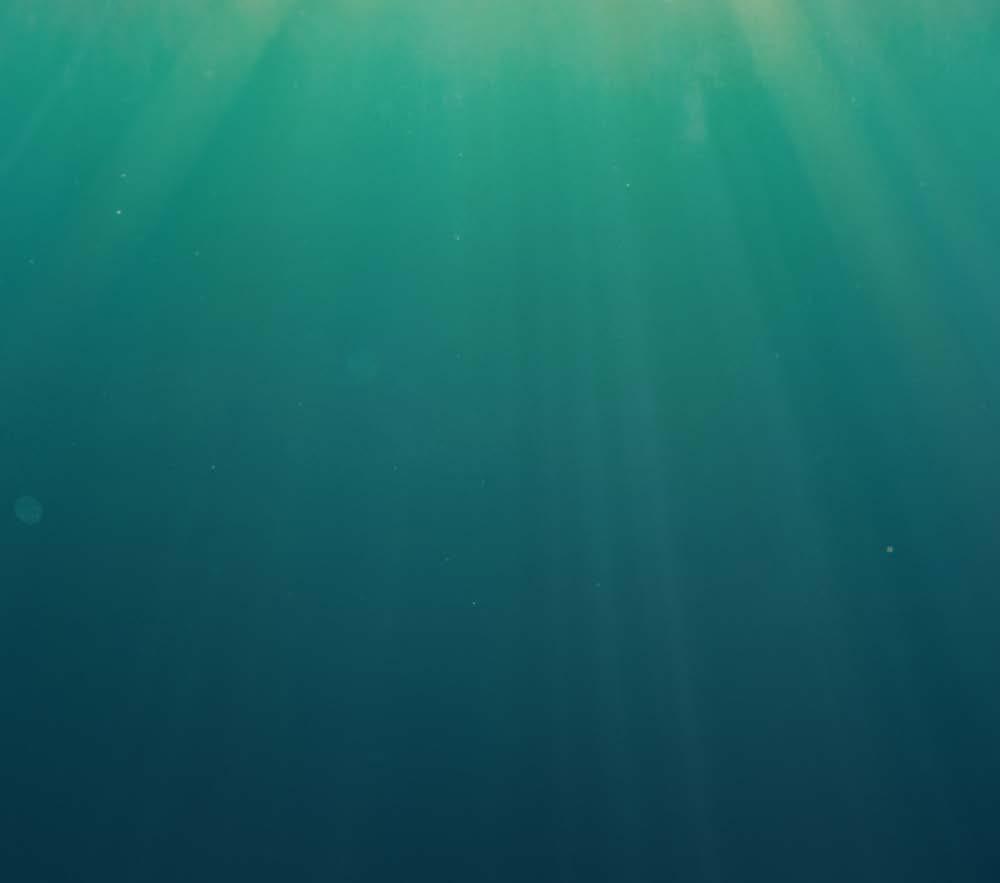
THE LINE - I use a hi vis line for almost all my fishing, open water or ice fishing. The ability to see your line has lots of advantages, something as simple as seeing what’s it’s wrapped on in the boat all the way to actually seeing the bite. Just being able to see how much slack you are putting into your jigging presentation is a huge benefit that will help you reproduce results or allow you to know what got you that bite in the first place.
Clam has the Frost series of line that is available in mono, fluoro and braid

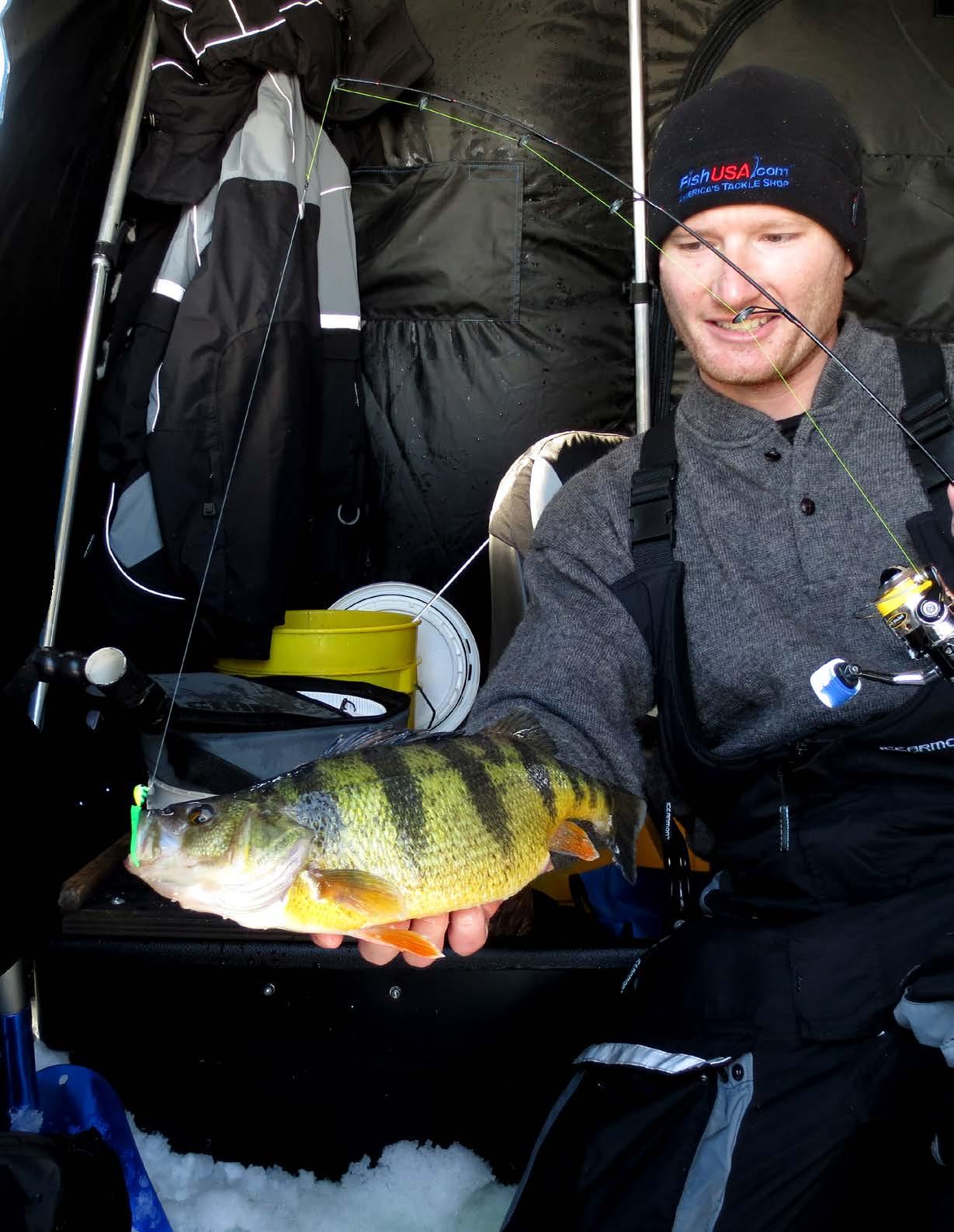
to fit any situation you come across, but most importantly all three types of line are available in hi vis colors that are very easy to see. The fluorocarbon line is available in metered, meaning it alternates sections of hi vis and clear. This allows you to cut the line to a clear section of fluoro for an invisible section of line to the fish, without having to mess with splicing in leaders.
THE ROD - I like using high quality fishing rods. Having a good quality blank will help you feel more bites, no question, but it isn’t always the answer. As previously mentioned there are times however that feel just isn’t enough. It’s under circumstances like this that a rod like the Meat Stick is invaluable. The Meat stick has a sanded down tip section that is very flexible and acts almost like a built in spring bobber. While most anglers use these as a dead stick and wait for the very whippy tip to load before even touching the rod, I can tell you from personal experience that they
work just as good as a jigging rod for perch and crappie as well.
THE TECHNIQUE - For years Michigan anglers have been watching line with a technique called tight lining. The name is kind of ironic because tight lining actually involves purposely leaving coils of

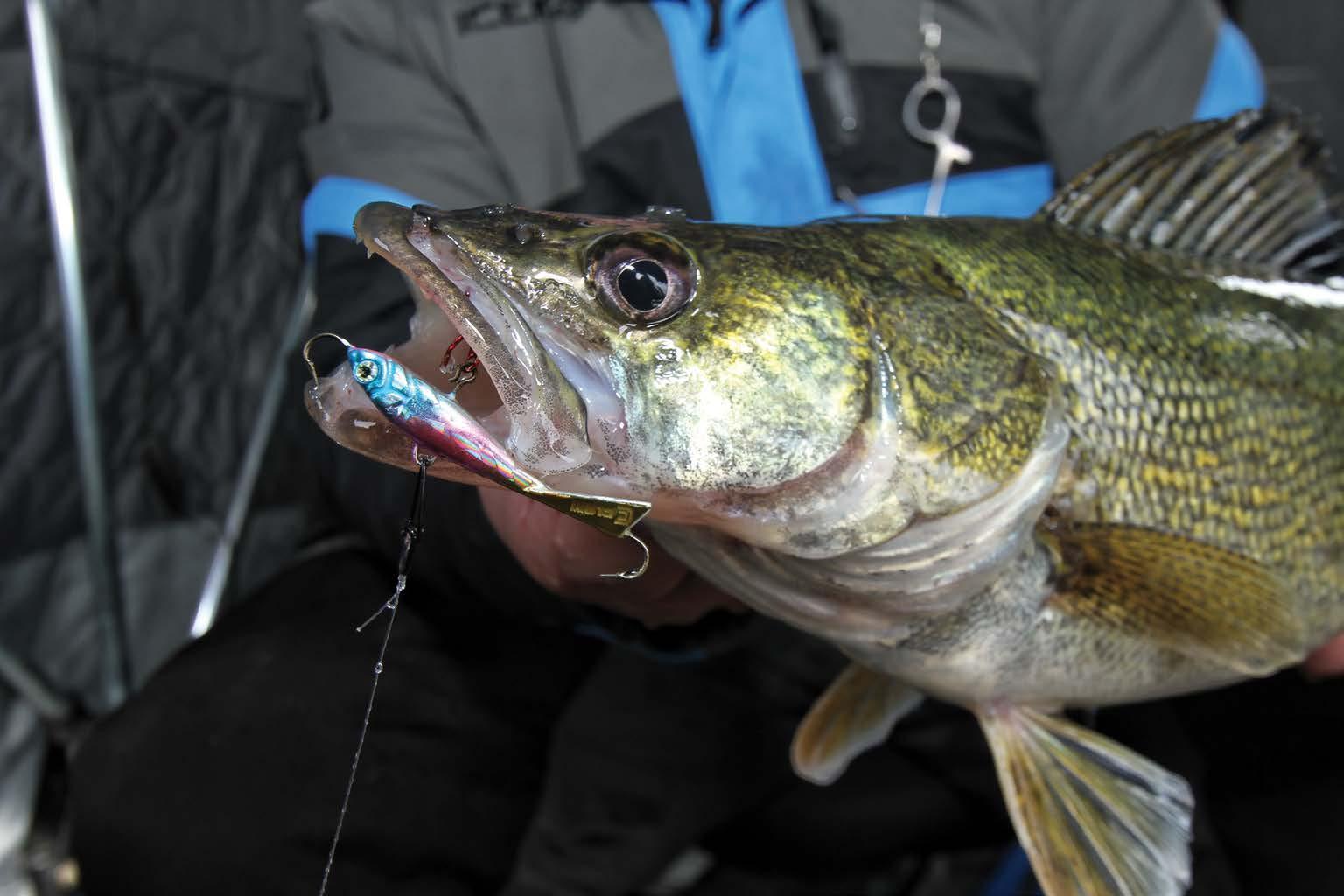
slack line, with the intent being that when a fish strikes they essentially pull the coil or slack out. When you see this you set the hook even without feeling the bite. While the technique is a little more complex than that layman’s description and takes some ice time to perfect, it’s one of the best ways to get light biters topside in a tough bite.
Clam Pro Tackle is now offering the hi vis gold monofilament line that this tactic was built on. Hardcore “tightliners” want monofilament so that the line doesn’t sink too quickly, and the loose coils can be seen in the water. Without this type of line the tactic is nearly impossible.
You don’t always have to have the most expensive gear to catch more fish, but just the right gear for the job. Whether you have stone hands or the fish are just being difficult, watching for a bite and not just waiting till you feel it will be sure to get more fish hooked this winter. n
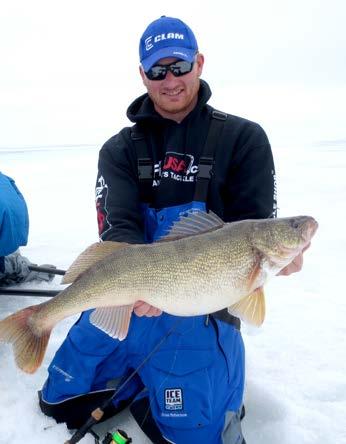 Ice Team Pro, Ross Robertson
Ice Team Pro, Ross Robertson

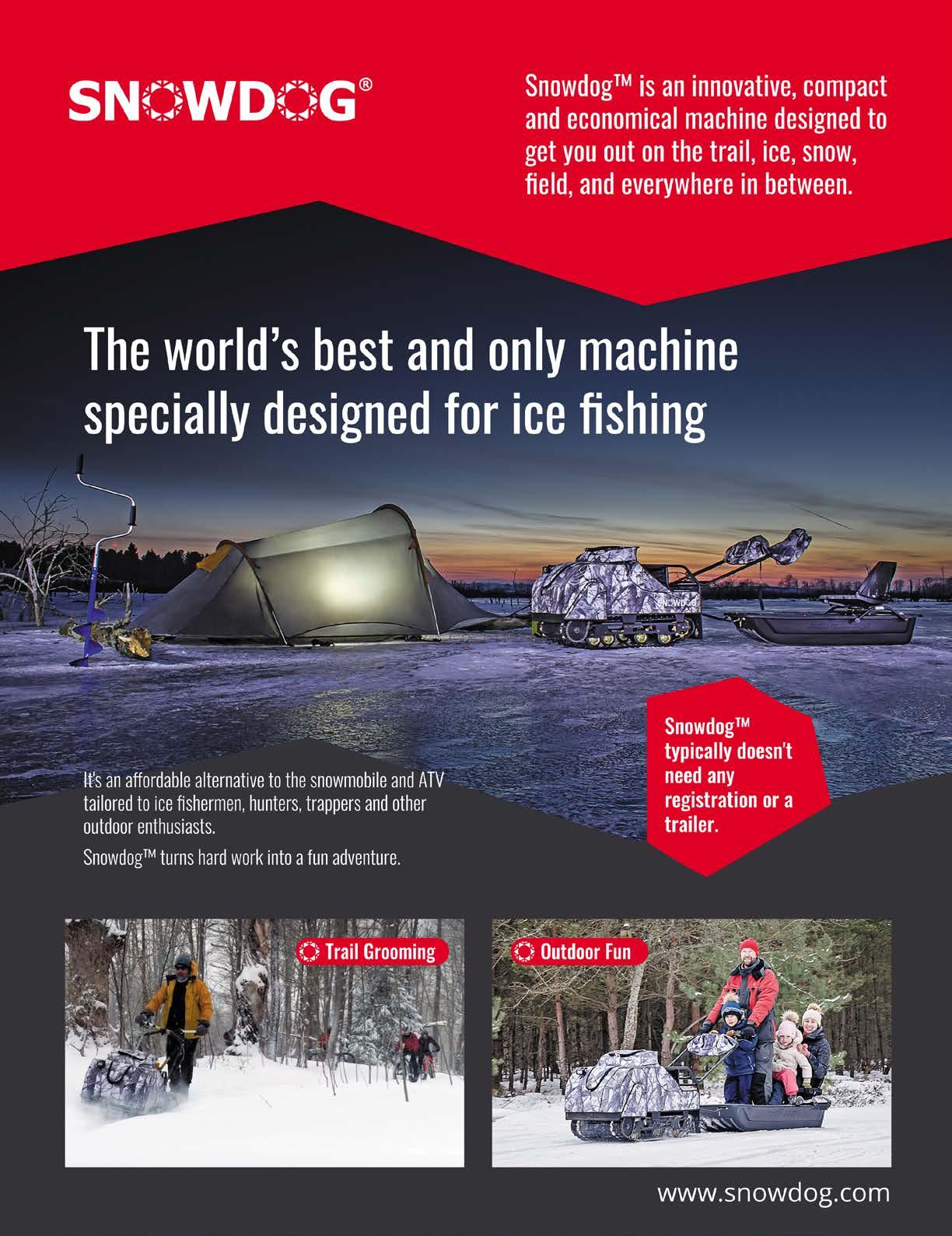
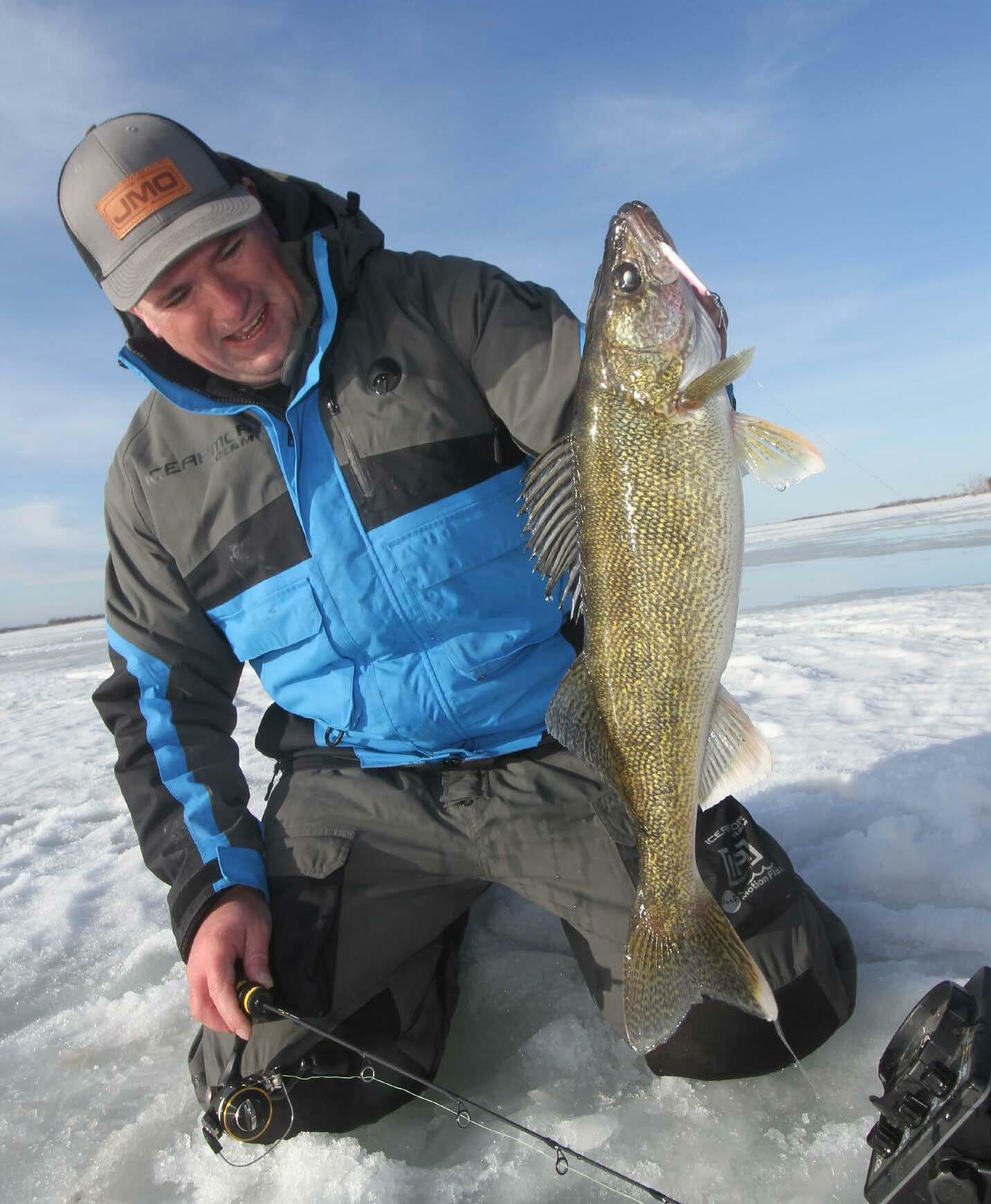
Early ice is a prime window for targeting walleye. Classic early ice locations typically repeat

the prominent fall locations. As a rule of thumb, good fishing in the fall often means good
fishing at first ice. Tough fishing in the fall can often translate to tough fishing at first ice.
Finding and catching walleyes right away in the ice season is often simply targeting locations where we put the fish to bed last in the boat. Fall fishing intel is some of the best intel for trying to find first ice walleye. Of course, there are perennial hot spots that for some reason or another just
fish well right away. Mille Lacs comes to mind along with Upper Red Lake.
As a rule of thumb, most prominent destination fisheries fish well at early ice and perhaps the single biggest reason is simply the rest these fish have had. There hasn’t been a boat or auger above these fish sometimes for a month. Generally, some of the first anglers that land on some of these fish experience good fishing and the
fishing generally goes downhill or gets tougher as people show up. By the time the ice can support a fullsize pickup, these early ice bites are often history. Early ice walleye fishing is often all about first come first serve but do so with safety in mind. Here are a few tips that really seem to be prominent in our travels each
winter. Pretty universal stuff that has produced walleye on several different fisheries across the Midwest.
Shallow Shoreline Structure seems to produce walleye on most fisheries at early ice. Probably a little bit out of necessity as the structure that is close to shore is some of the very earliest
locations we can reach by either foot or with an ATV. Large prominent pieces of structure however that are connected to the shoreline often load up with walleye at early ice. My favorite locations are shallow reef complexes that are connected to the shoreline. Shallow might be five feet or fifteen feet depending on the water. Good bottom might be sand, gravel or rock but these types of spots just seem to produce walleye at early ice on many different fisheries. Shoreline points and flats that have a decent access to deeper water can all be good. If given the choice, I personally like to target the larger spots if I can get there first. These types of spots often fire up at sunrise, sunset or after dark and are done by the time a crowd gathers.
Aggressive lures and cadences trigger fresh fish. Much has been said about reaction baits or call baits that are used to trigger aggressive strikes and bring fish in from a distance. More so than the exact individual
lure is that attitude. You can fish a ¼ ounce lead head jig aggressively and trigger fish. Early ice walleye can often be extremely aggressive and respond well to aggressive presentations. Use this to your advantage, not just for triggering fish but also breaking down water and eliminating dead areas. If you are fishing through fresh ice, be confident that if there are any fish around, some will meet you halfway and find you. More so than any time of year except for late ice, you can eliminate water so quickly. Loud rattles like the CPT Rattling Blade Spoon are deadly for ringing the bell. High action glide baits like the CPT Tikka Mino or vibration baits like the Salmo Rail Shad are all deadly for finding and triggering aggressive walleye.
The noise factor can be a big factor at early ice. Noise can kill a bite at any time of year but the severity of noise seems heightened at early ice when you are dealing with a lot less ice on what is often shallow water. We have
seen many situations where walking with ice cleats spooked fish away. There have also been times when dragging a Fish Trap or sled on the ice shut down the spot. Obviously, you must make some noise to set up on a spot but be conscience of noise and try to keep noise to a minimum. If you can, drill a lot of holes where you plan on fishing a good hour or so before the anticipated prime time.

Get set up off the structure with your ATV and gear and walk in with your auger. Walk softly and try not to drag or drop anything on the ice. Use a head lamp and be careful with bright light when fishing
Better Bait, Better Fish
Comfortable Foam Seat
Quick Release Hatch & Water Tight Seal for No-Spill Transportation Water Circulation & Aeration Delivered By a Johnson Pump Aerator & 6” Aerator Head

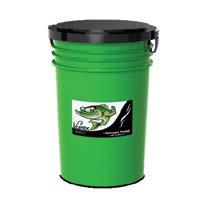
Domed Stainless Steel Strainer for Easy Cleaning & Bait Protection
Rechargeable 12V DC Battery & Bait Well Kit with On/Off Switch
Easily Converts to Summer Use with Slow Release Ice Trough to Keep Water Cool


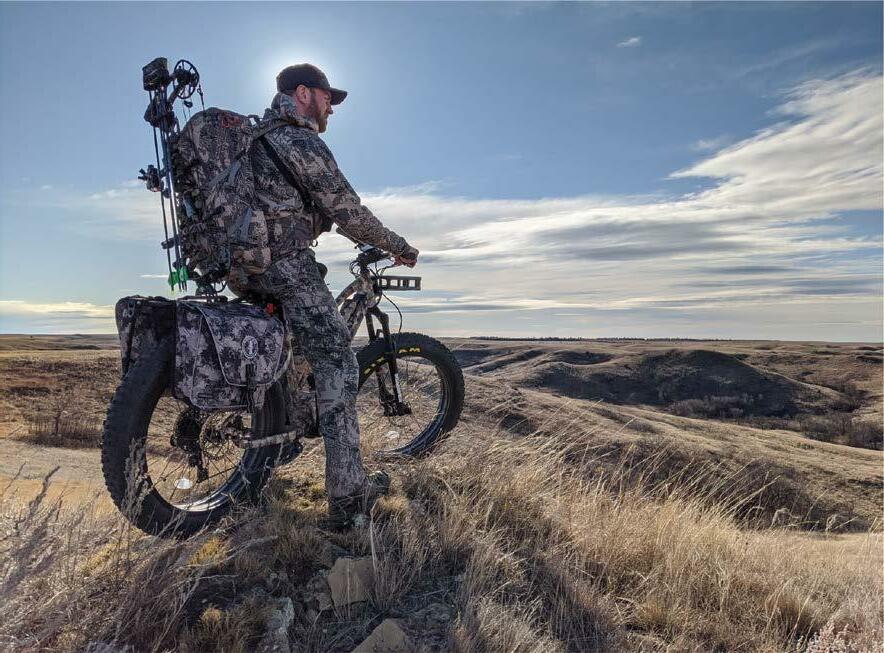



after dark. When fishing through locations where there is thin ice that is clear enough to see through, slow down and let the spot settle down as you fish. Spooking fish that are bumping off your presence often need five to twenty minutes to come back so it can be easy at times to miss fish by moving too aggressively in thin water on top of thin ice.
Remote lines like tip ups can play a huge role on shallow walleye at early ice. Doesn’t have to necessarily be a tip up but tip ups are just so deadly as a remote set line. When fish are spooking and not letting you get over the top of them, tip ups can save the night. Situations where we have seen this become prominent are fisheries with less than eight inches of clear ice over crystal clear water. If you can see


through the ice and see bottom in eight feet of water as you are walking out on early ice, set out as many tip ups as you legally can. We have seen times when the tip ups became such a factor in this type of situation where we ended up setting out every tip up we legally could and literally sat on shore twiddling our thumbs waiting for a flag to pop up. Larger creek chubs and sucker minnows are ideal especially after dark or when targeting big fish. Don’t be afraid to get up higher than halfway in the water column in shallow water after dark.
Avoid Wind Turbidity. Wind is often cliché with walleye fishing during the open water season but really strong winds right at freeze up can really disrupt some fisheries at first ice. Forty mile per hour winds right at freeze up can have a major effect particularly on small, shallow dish bowl type lakes but we have even seen this wind effect on much larger fisheries like Lake of the Woods. There are a couple of indicators of this phenomenon. Jagged broken up ice that is stacked up and extremely
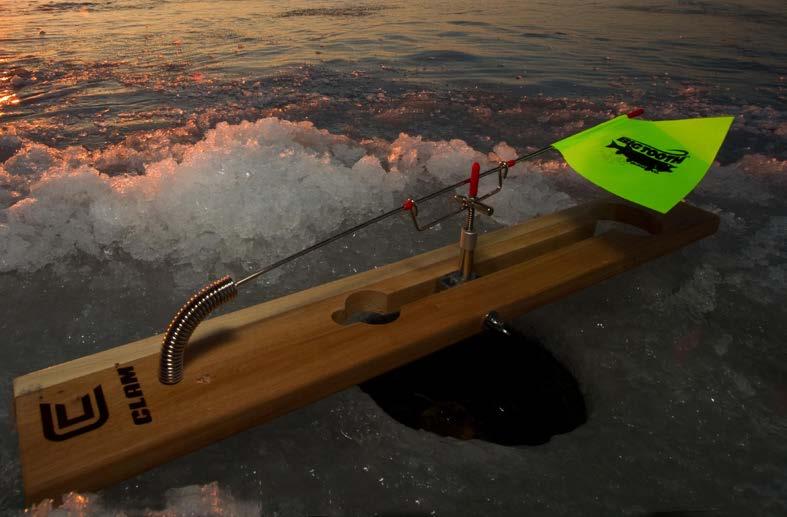
dirty and turbid water. When you can’t see the bottom of the ice when fishing on four or six inches of ice, you are going to have really tough fishing and the best bet is to simply pick a different lake. Forty mile per hour winds can churn up a lake at any time of year but normally that stirred up sediment clears up in a handful of days. When the water gets colder and denser however, that sediment hangs in the water much longer and can take several weeks to clear up. Obviously, these lakes will fish better as winter progresses and the water clears up.
The early ice period produces great walleye fishing but fishing early ice can be much different than other times of the year. Fish can be extremely aggressive but easily spooked. Reports will often be limited so fall fishing memories are often the best starting point. Prioritize ice safety and always have flotation rope and an ice bar or ice chisel for checking the ice thickness as you walk. While many of the classic walleye bites happen at sunset or shortly after dark, get
out plenty early so you can drill your holes and let the commotion settle down. No doubt there are few things as rewarding as landing the first big walleye of the winter through four inches of clear ice where you can actually see the fish fighting through
the ice several feet to the side of you. Landing big walleye through a hole in less than six inches of ice is tricky because the fish don’t turn and can sure back up easier. Reach your hand below the ice and pin them to the bottom of the ice. n


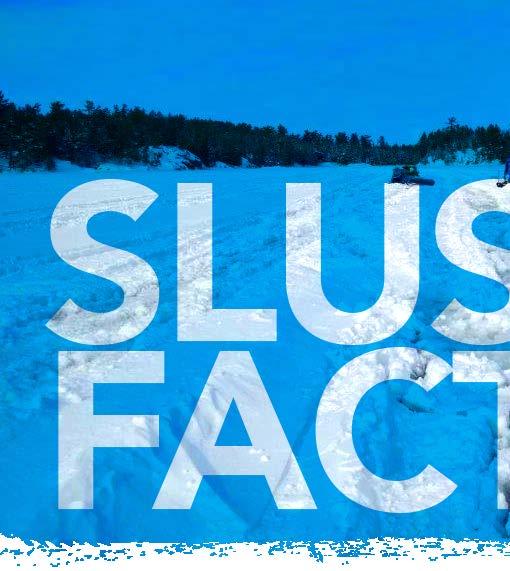
Slush can make an otherwise enjoyable winter fishing trip downright miserable. But with the right precautions, pre-trip prep and a solid game plan for getting unstuck, you can still access your favorite hotspots and experience fine fishing all season long.
Here’s what you need to know to fight slush and win.
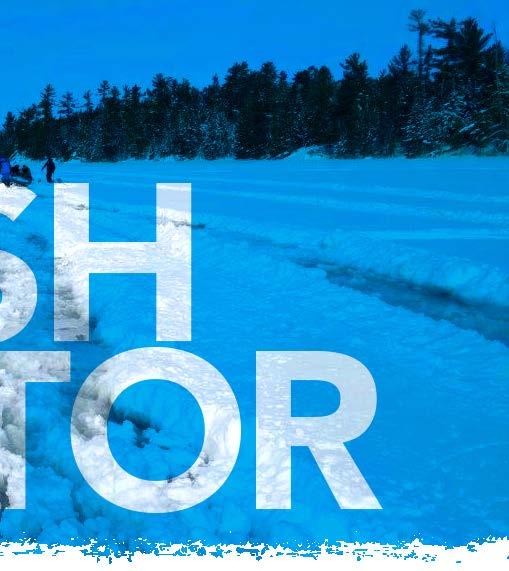
Let’s start with Slush 101. Slush forms when the weight of deep snow pushes down on the ice and water seeps upward through holes and cracks. The snow protects the resulting slushy mixture from the cold, allowing pockets of the nasty stuff to flourish even when air temperatures dip well below zero. Slush depths can range from a few inches to over knee deep.
Not surprisingly, slush greatly hinders an angler’s mobility. Slogging from hole to hole in deep slush for a few hours cab make you feel like you ran a marathon in diving boots. For the purposes of this article, we’ll focus on the vehicular side of slush countermeasures. These are every bit as important as slush-related fishing tips, because getting stuck in slush can range from a minor hassle to a downright life-threatening situation if you’re stranded offshore in bitter weather conditions.
Avoiding slush is ideal. Unfortunately, slush pools often lurk sinisterly beneath seemingly safe snow-packs. One minute you’re driving your
snowmobile to the fishing grounds and the next, you’re bogging down in winter’s version of quicksand. It’s even worse when an ATV or pickup’s wheels break through the upper crust and the vehicle bottoms out in the slop. Since the latter situations are especially problematic, I greatly prefer snowmobiles whenever slush is possible, and will focus on snowmobile-related tips from here on out.
Scouting can help you avoid trouble spots. If I think slushy conditions might exist on a lake I’m going to fish, I make a run out to the fishing area with my snowmobile—before loading the sled down with gear. Once I dial in a slush-free trail, I’ll head back to gear up. Note: In the right conditions, you can make a few quick passes over modestly slushy areas the night before a trip, so the cold hardens a trail for safer passage the following day.
Be forewarned, just because you don’t find slush on the way to the fishing grounds doesn’t mean it won’t become a factor at some point during the trip. For example, lake water can surge upward through drilled holes, creating a sea of slush that will cause headaches when it’s time to leave.
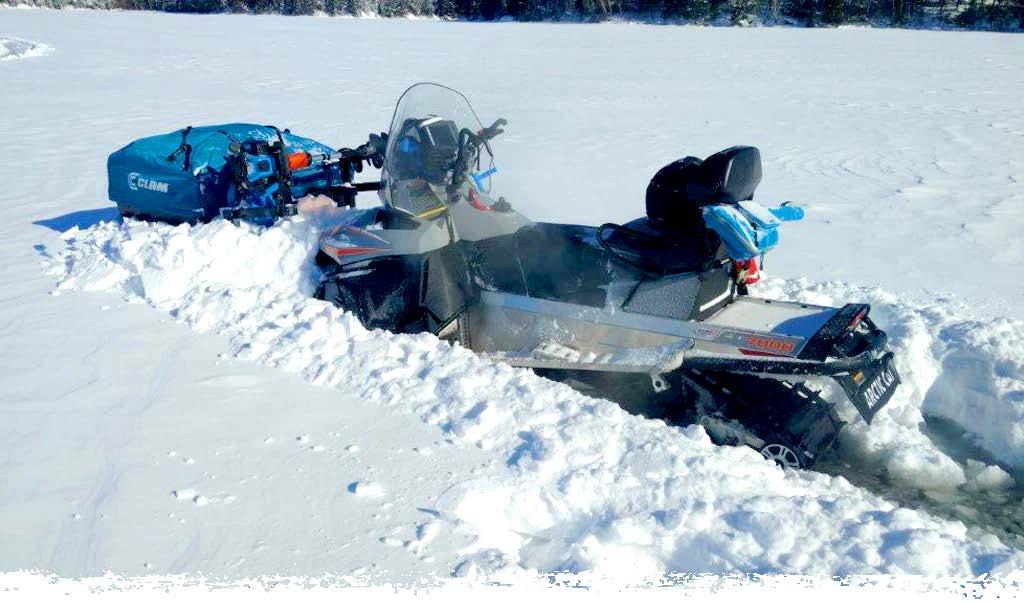
The right gear can keep you from getting into a jam, and help you get out of one if you do. Let’s start with the snowmobile. A wide track and powerful engine are great allies in slush. The super-size track can help
Scouting can help you avoid trouble spots. If I think slushy conditions might exist on a lake I’m going to fish, I make a run out to the fishing area with my snowmobile— before loading the sled down with gear.
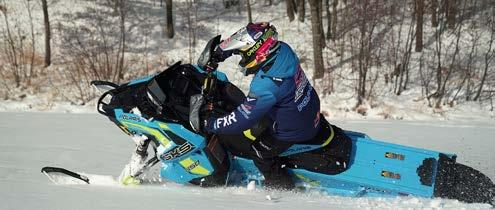


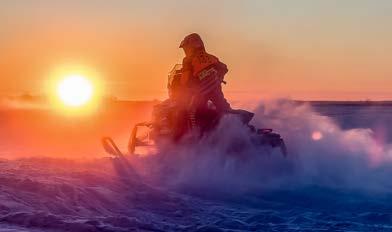

power than I need, as in the past I ran under-powered sleds that didn’t have enough muscle to spin the track when the chips were down.
into what might best fit your needs. I personally run an Arctic Cat Bearcat, which has a great combination of track width, power
Gear management is also important. Take only what you need for the day and don’t overload your snowmobile. Keep the load evened out, too, and
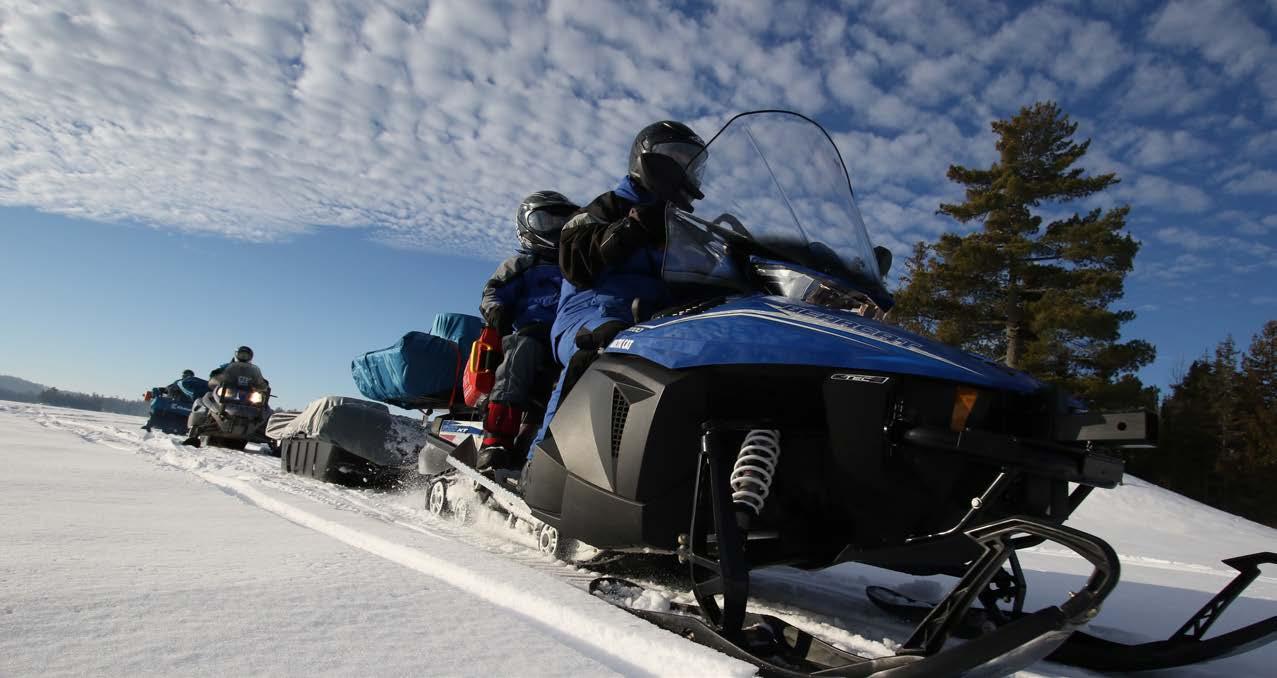

don’t overload the front of your sled. I learned the hard way years ago that nose-heavy snowmobiles
slush.
I like to fish out of a Fish Trap Scout, which I load on the back of my snowmobile. This keeps weight off the front of my sled. Plus, it keeps the shelter off the ice and out of harm’s way. Dragging a shelter can cause snow to pile up in front or on top of it, making it harder to pull.
If you do tow a shelter, make sure it has a cover or you could end up filling it (and any gear aboard) with slush when you hit the throttle.
A fully charged cell phone is a musthave, not just for taking fish photos but also for calling for help if you’re stranded. Also remember to tell someone where you’re headed and when you plan to return. That way rescue won’t be far away if you don’t hit shore on time.
On the apparel front, waterproof allrubber knee boots are a godsend
in slush. They keep your feet dry and warm and make it hard for slush to slop over the tops. Trust me, you don’t want to add the misery of cold, wet feet to the mix when you’re struggling in slush. I’ve worn Clam’s Sub-Zero boot during countless slush encounters and highly recommend it because of the warmth and removable liners.
As added precautions, I always carry a tow strap at least 50 feet long and a snow shovel. If you are traveling with fishing companions and someone bottoms out, you

can usually drive by the stuck sled a few times to make a path, then circle back and hook up the strap to help pull them out. By the same token, fellow snowmobilers can use the strap to pull you out as well. The shovel is infinitely better than hands, feet or five-gallon buckets for breaking trail or clearing slush from a stuck machine.

When you hit slush, stay on the throttle and do everything in your power to keep moving. Sometimes rocking the sled left to right will help the track grab enough traction to crawl through the slop. If you need to turn to avoid getting into worse trouble, change course as gradually as possible. Avoid slowing to make sharp turns, and don’t stop unless you must.
If you do become stuck, stay calm. Panic and anger only make things worse. Assess the situation and your options, then calmy and safely get yourself out of trouble and back to your fishing adventures! n
A fully charged cell phone is a must-have, not just for taking fish photos but also for calling for help if you’re stranded.
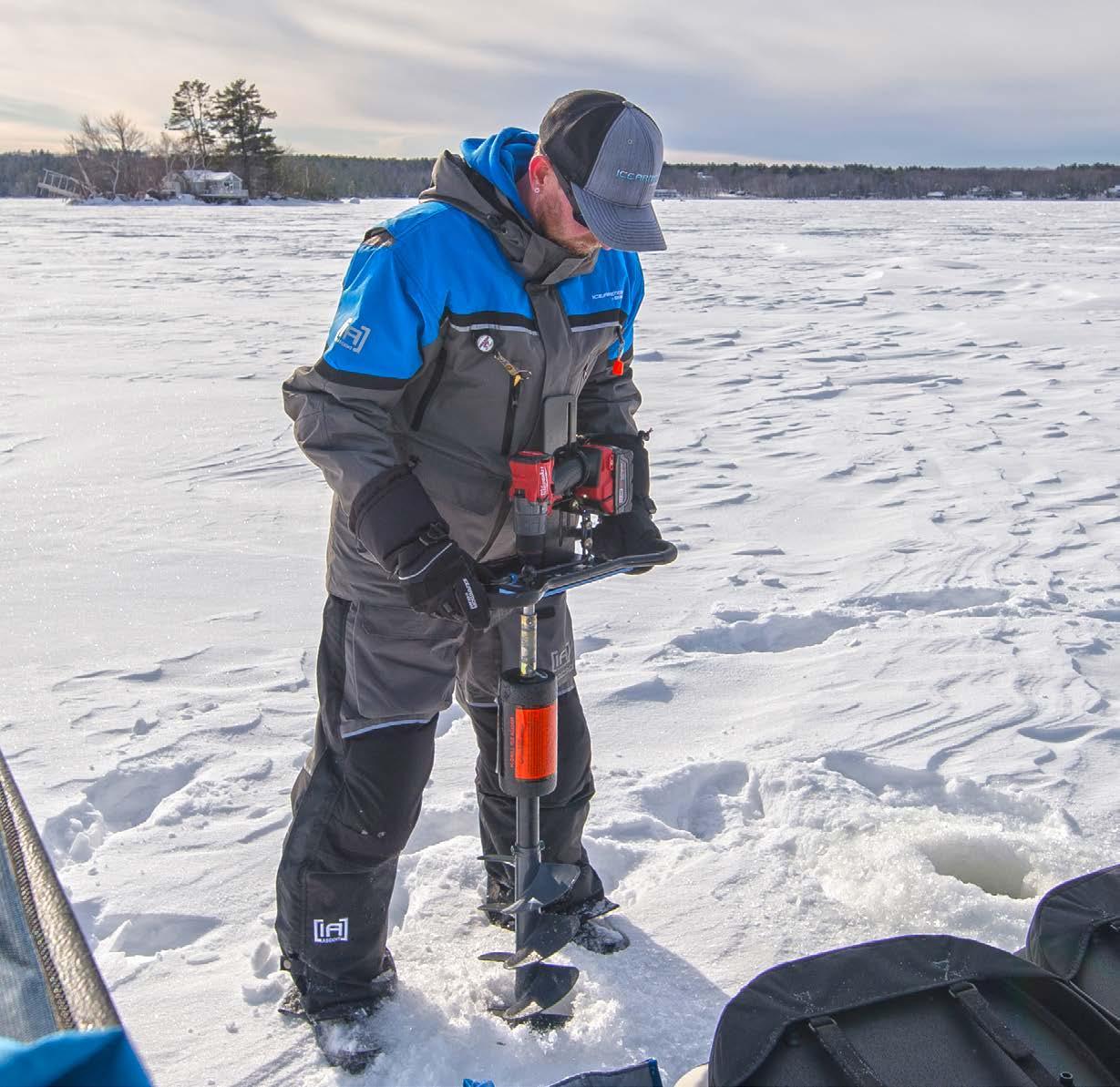
Asystem is a series of steps that work together to complete a task. In this year’s Ice Annual Magazine, I wrote about some techniques to give you an edge while ice fishing. I talked about how that edge doesn’t always come in the form of a new lure, although it might, but often comes in by way of several more subtle things that anglers don’t always attribute directly to their ice fishing success. Another way to find success is sometimes as simple as a different perspective. How do businesses, like manufacturing facilities, find their success? One way they speed up productivity is to develop a system. You can’t catch fish if you’re not actually fishing, so anything that helps you keep your line in the water more will most definitely result in more fish on the ice.
You hear a lot about efficiency in ice fishing circles. Efficiency and system are somewhat synonymous with one another. My system starts off the ice in how I store my rods, tackle and other gear. I use a double-sided rod locker to store the bulk of my rods. I keep it in my snowmobile trailer. This allows me to grab as few or as many as I want for the day. When I’m traveling on the ice, I use a singlesided rod locker. The single-sided case takes up less space, but still protects my rods. Regardless of the case, every one of my rods has a rod

slick on it. Nothing will cost me time like untangling rods that don’t have slicks on them, and I know exactly when they will be tangled the worst… when I need them the most. At least that’s how it feels when a huge school of feeding fish shows up under me. Time without my line in the water feels like slow motion.
Tackle storage is equally as important to me, especially with the evolution of tungsten. Tungsten is more expensive than lead. Loose jigs bouncing around the inside of a standard tackle box are likely to have the paint chip off or fall out, only to become stuck in other places and cost you time, or worse, lost and gone forever. Clam Outdoors makes it easier than ever to store tackle. They have a several different sizes of both jig and spoon boxes. You can do what I do and use a large jig box and the Deluxe Spoon
Box to house the bulk of my tackle. I have a small jig box loaded with my most commonly-used jigs and space for a few substitutes as needed. I do the same with my spoons. Leech Flutter Spoons and Blade Spoons are a staple for me. I keep the majority of my spoons in a Deluxe Spoon Box and when I’m not guiding, I take a small spoon box with my favorites for the day. Staying organized means less time searching for tackle and more tie fishing.
I don’t appreciate organization as much as I do when I get to my fishing spot, but my system doesn’t end there. For years I had a habit of setting everything I thought I would use where it would be easily accessible. I thought that by having everything ready, it would save me time if I needed it. It wasn’t until after I met Dave Genz that I began to look at efficiency from a different perspective. I realized I almost never needed many of the object I was getting read. By taking most of my gear out I was costing myself time and essentially anchoring myself to an area in order to avoid having to put everything away. News flash Tim, you have to put it away at some point. Today, when I arrive at a fishing spot, I put anything I’m not actually using at that moment back where it belongs. If a school if fish moves on and I want to go with it, or they never appear in the first place and I need to quickly change locations, I can do so much easier and faster if the majority of my gear is put away.
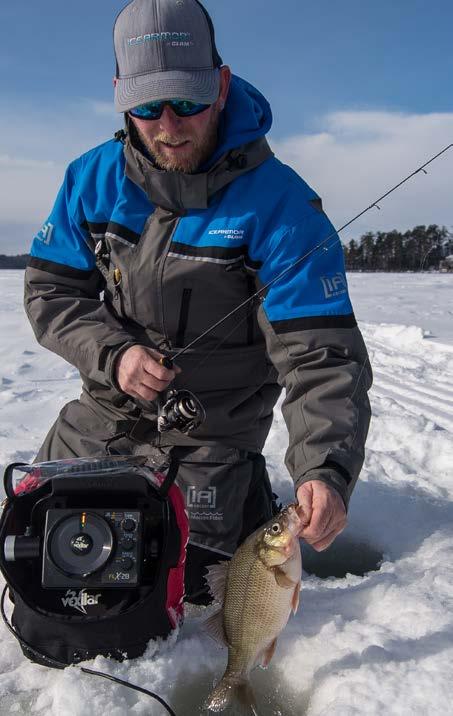
There are many ways to make yourself more productive. Having a system is by no means the end-all key to success, but it makes a great foundation to build other skills off. Have fun creating your own system based on tips from others and steps you create yourself. Then put your stamp on it and own it. Having an effective system makes ice fishing more productive and easier, and therefore more fun, with the latter being the most important. n

It’s that time of year again, the days are growing shorter, the leaves have turned colors and the water temperatures are dropping with each passing day. To ice anglers, this starts to trigger our brains into thinking about first ice! Here’s a few tips on how to key in on fall panfish movements and behavior so you can put them topside come first ice.
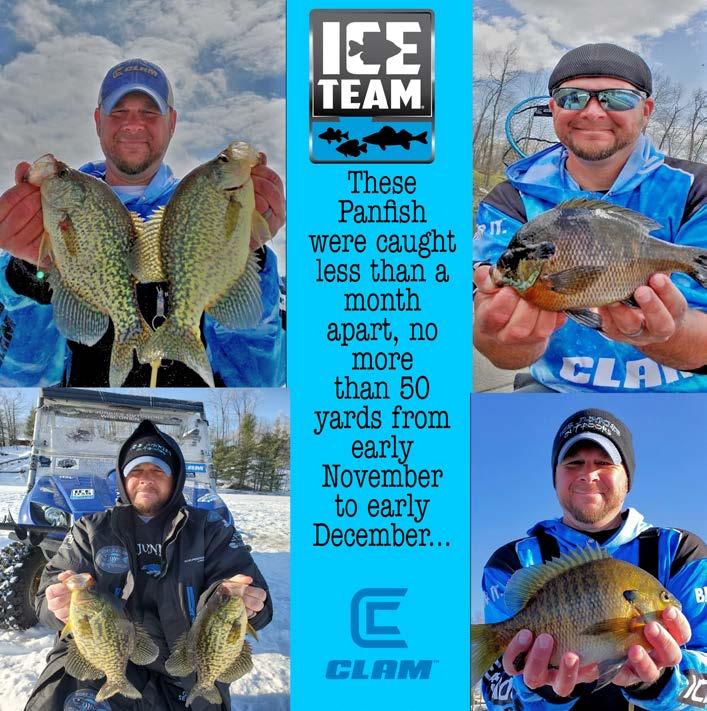
As the water begins to cool and lack of sunlight becomes more evident each day, panfish will begin to school up in larger numbers and start their migration from deeper basins and deeper weed lines where they’ve been hanging most of the warmer months when water temps were at their peaks, up to relatively shallower weed flats and structure where the water has cooled down a bit and go into “Fall Feedbag Mode”. This mode will typically last two to three weeks and provide some of the year’s best open water fishing for panfish anglers! It’s this time frame where I start to think about first ice. As the fall season progresses into late October, early November, ice anglers should really start to pay attention to a few important details...what are these fish eating, where are these fish currently located, where is their food source moving to and where is it going as water temps continue to drop? With today’s electronics it can be easy to answer these questions, as you can practically watch it all play out day by day on the screen of your unit. You’ll begin to see pods of baitfish and bugs “schooling up”(these will be the smaller marks on your screen) ...the panfish won’t be far away from them (larger marks, typically below or adjacent to these bait pods). Fish typically seek out two things this time of year...they need to be comfortable and have a food source.
By now, the majority of your panfish will have moved back to your deeper basins due to water temperature and food sources, though some will remain in the deeper surviving weeds/weed lines if there’s a source of food available for them. The greater numbers of fish, however, will generally be found over your basin areas. When fish are in greater numbers and competing for food, your catch rates will increase!
To simplify all the above...find a map of your desired body of water, pinpoint on the map where you were catching fish in the fall and draw a
line from there to the basin area of your lake. The panfish will be located somewhere in between. Find out what food sources are available to them by using an underwater camera off your boat, or by doing seasonal research on your lake by staying in tune with your surroundings (are there water bugs present on top of the water during summer months, are there mayfly hatches that take place or was there a good class minnow fry up in the shallows that you noticed?) Use that gained knowledge to “match the hatch” and you will have put yourself in a position to be very successful come first ice! n
